EARLY MONOPHONIC SYNTHESIZER Ondes Martenot (1928) klangerzeuger
EARLY MONOPHONIC SYNTHESIZER Ondes Martenot (1928)
**
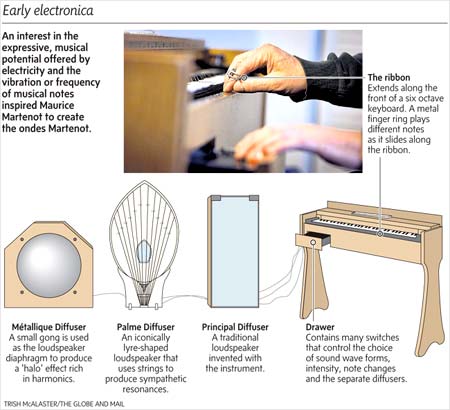
Speaker system
The ondes Martenot, French for "Martenot waves"), also known as the ondium Martenot, Martenot and ondes musicales, is an early electronic musical instrument that Maurice Martenot invented in 1928. The original design was similar in sound to the theremin.[1] The sonic capabilities of the instrument were later expanded by the addition of timbral controls and switchable loudspeakers.
The instrument's eerie wavering notes are produced by varying the frequency of oscillation in vacuum tubes. The production of the instrument stopped in 1988, but several conservatories in France still teach it.[2] Since 2008, Jean-Loup Dierstein, with the support of Maurice Martenot's son, has been building ondes Martenot instruments based on the model used when production stopped in 1988.[3]
In 1997, the Ondéa project began designing an instrument based on the ondes Martenot. Since the Martenot name is still protected, the new instrument is called Ondéa, but has the playing and operational characteristics of the original ondes Martenot. In 2001, a completed prototype was first used in concerts. These instruments have been in regular use since 2005.[4][5]

therevox
In classical music
The ondes Martenot has been used by many composers, most notably Olivier Messiaen. He first used it in the Fête des Belles Eaux for six ondes, written for the 1937 International World's Fair in Paris[6] and then used it in several of his works, including the Turangalîla-Symphonie and Trois Petites Liturgies de la Présence Divine. His opera Saint-François d'Assise requires three of the instruments. The composer's widow, Yvonne Loriod-Messiaen arranged and edited four unpublished Feuillet inedits for ondes Martenot and piano which were published in 2001[7]. The ondes Martenot has also been used occasionally in transcriptions: Leopold Stokowski used the instrument in his ethereal orchestration of Buxtehude's Sarabande and Courante ("Auf Meinen Lieben Gott").

Other composers included Charles Koechlin, Edgard Varèse (as a replacement for two theremin instruments in his work Ecuatorial), Arthur Honegger, Darius Milhaud, Maurice Jarre, Antoine Tisné, Sylvano Bussotti, Giacinto Scelsi, Marcel Landowski, Pierre Boulez, Tristan Murail, Henri Tomasi, and Frank Zappa. André Jolivet wrote a prominent concerto for it in 1947.[8] Bohuslav Martinu* authorized the adaptation of his Fantasie to the use of the ondes Martenot when it proved difficult to perform on the Theremin, for which it was originally written.[9]

Estimates of the number of works written for ondes Martenot vary. Hugh Davies reckoned there to be around a thousand works composed for the instrument.[10] Jeanne Loriod's figures are the more widely quoted: she estimated that there were 300 pieces of chamber music, including 14 concertos.[citation needed] Jacques Tchamkerten's provisional catalogue of works for ondes, included in the current reprinting of Loriod's Technique, lists far fewer works than either of these figures.[11]
In cinema and television

Its first use in the cinema was by Shostakovich for one of Russia's first sound films, Odna in 1931. Arthur Honegger used it for Berthold Bartosch's film The Idea (1930, score added 1934). It was extensively used by composer Brian Easdale in the ballet music for The Red Shoes. It was frequently used in horror and science fiction movies and television, notably in the 1950s. British composer Barry Gray frequently used it in his scores for Gerry Anderson's television series, and American composer Dominic Frontiere used it in a few episodes of the television series The Outer Limits (1963-65). Film composer Elmer Bernstein incorporated the instrument into many of his works beginning with Heavy Metal, in 1981. Maurice Jarre was also noted for his use of the instrument. It was used to haunting effect by the composer David Fanshawe in the British television series Flambards. One of the few anime composers who has used the instrument is Takashi Harada in the soundtracks of A Tree of Palme (2002) and in Bincho--tan (2006).

Other film scores using the ondes Martenot include Lawrence of Arabia (1962); Billion Dollar Brain (1967); Doppelgänger (1969); Jesus of Nazareth (miniseries) (1977); Heavy Metal (1981); Ghostbusters (1984); A Passage to India (1984); The Black Cauldron (1985); Tucker: The Man and His Dream (1988); Rising Sun (1993); Amélie, by Yann Tiersen (2001); both Bodysong (2003) and "There Will Be Blood" (2007) by Jonny Greenwood of Radiohead; La marche de l'empereur, by Emilie Simon, played by Thomas Bloch. The score of A Tree of Palme also notably features the ondes Martenot.

It was not used for the female voice effects in the original Star Trek theme, despite many rumors to the contrary.[citation needed]
In popular music
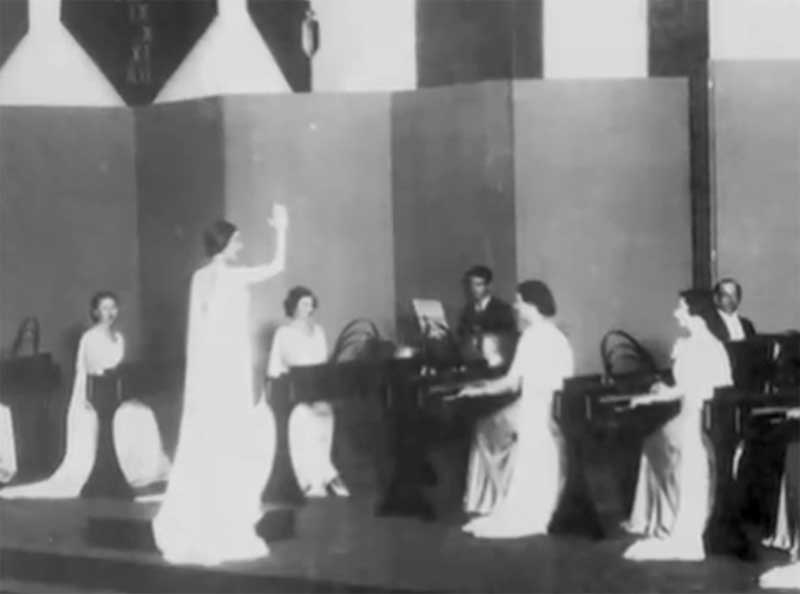
One of the first integrations of the ondes Martenot into popular music was achieved in the Quebec musical scene. The two most popular Québécois musical groups of the time, Beau Dommage and Harmonium, made extensive use of this instrument (introduced there by Marie Bernard) in each of their 1975 albums, respectively Où est passée la noce? and Si on avait besoin d'une cinquième saison. Harmonium later toured with Supertramp and received several reviews of their work by English-speaking musical critics of progressive rock, who noted their use of the ondes Martenot.
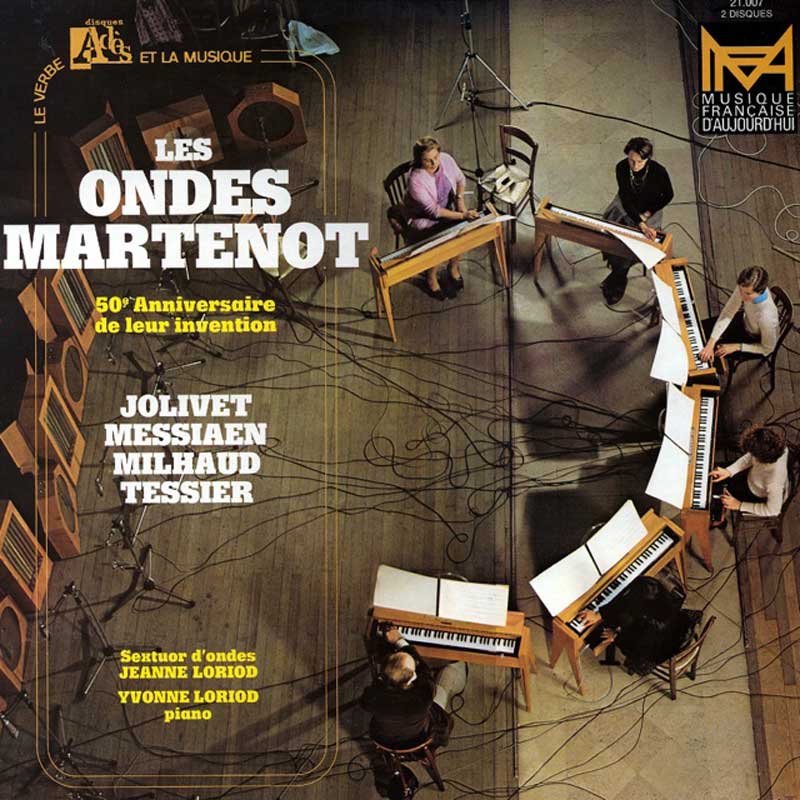
Jonny Greenwood is often credited with bringing the ondes to a larger audience through Radiohead's Kid A (2000), Amnesiac (2001), Hail to the Thief (2003) and In Rainbows (2007) albums. Greenwood uses the ondes Martenot often in his solo efforts, and has written a piece for the instrument, entitled Smear. In live concerts, Radiohead have used six ondes for "How to Disappear Completely".[12]
The ondes Martenot was also utilized by Bryan Ferry, in 1999, on the album As Time Goes By, and by Joe Jackson on his 1988 soundtrack album for Tucker: The Man and His Dream and his 1994 album Night Music. Recently, ondist Thomas Bloch has toured in Tom Waits and Robert Wilson's show "The Black Rider" with Marianne Faithfull (2004–2006) and in Gorillaz leader Damon Albarn's show "Monkey: Journey to the West" (2007 onward).

Also, Yann Tiersen, well known for writing the music to Amelie, often features the use of the ondes Martenot in his music. His DVD La Traversee, documenting the recording of Les Retrouvailles, shows his use of the instrument.
In 2009, bruit direct disques[13] released a 12" 45rpm vinyl record of original ondes martenot compositions by Accident du travail[14].

Playing technique Au ruban playing technique The tiroir of a 1975-model ondes
The ondes Martenot is unique among electronic musical instruments in its methods of control.[15] Maurice Martenot was a cellist, and it was his vision to bring the degree of musical expressivity associated with the cello to his new instrument.[16] The ondes, in its later forms, can be controlled either by depressing keys on the six-octave keyboard (au clavier), or by sliding a metal ring worn on the right-hand index finger in front of the keyboard (au ruban). The position of the ring corresponds in pitch to the horizontal location along the keyboard. The latter playing method allows for unbroken, sweeping glissandi to be produced in much the same manner as a Theremin. The keyboard itself has a lateral range of movement of several millimeters, permitting vibrati of nearly a semitone below or above the pitch of the depressed key to be produced.

By depressing keys or moving the ring, no sound is initially produced. A control operated by the left hand and situated in a small drawer of controls (tiroir) on the left side of the instrument controls the musical dynamics, from silence to fortissimo. This control (touche d'intensité) is glass and lozenge-shaped, and can be depressed several centimetres. The depth to which this key is depressed determines the dynamic level: the deeper, the louder. The manner in which it is pressed determines the attack of the note: quick taps produce staccato articulations, whilst more controlled and deliberate depressions are used to play legato.

The small drawer of controls also contains flip-switches to control the instrument's timbre. These function in much the same way as a pipe organ's stops can be added or removed. Like organ stops, each switch has its own sound color which can be added to the chorus of other timbres. The 1975-model instrument features the following timbres:
Onde (O) A simple sine wave timbre. Similar in sound to the flute or ocarina.
Creux (C) A peak-limited triangle wave. Similar in sound to a clarinet in high registers.
Gambe (G) A timbre somewhat resembling a square wave. Intended to be similar in sound to string instruments, as the French title would suggest.
Petit gambe (g) A similar but less harmonically-rich timbre than Gambe. The player can control the number of harmonics present in the signal by using a slider situated in the control drawer.
Nasillard (N) A timbre resembling a pulse wave. Similar in sound to a bassoon in low registers.
Octaviant (8) A timbre with a reinforced first harmonic whose intensity in the signal can be controlled by using a slider. This setting is analogous to the 4 foot stop in organ terminology.
Souffle (S) A timbre often described as white noise, but in fact pink noise of indefinite pitch.
In addition to the timbral controls, the control drawer also contains flip switches which determine to which loudspeakers (diffuseurs) the instrument's output are routed. These are labeled D1 to D4.
Three diffuseurs. From left to right: Métallique, Palme, Principal
D1
Principal A traditional, large loudspeaker.
D2
Résonance A loudspeaker which uses springs to produce a mechanical reverb effect.
D3
Métallique A small gong is used as the loudspeaker diaphragm to produce a 'halo' effect rich in harmonics.
D4
Palme An iconically lyre-shaped loudspeaker, using strings to produce sympathetic resonances.
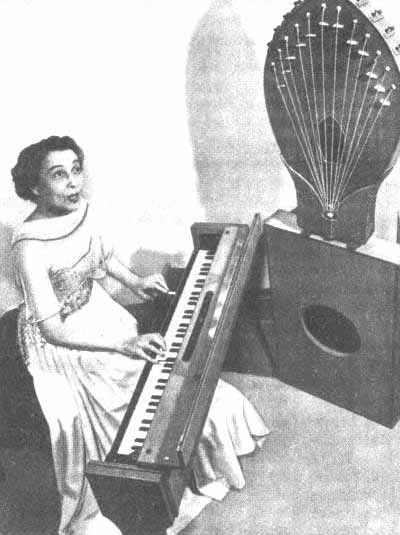
* The Electro-Theremin is a similar instrument, famous for being used in the song "Good Vibrations" by the Beach Boys.
* Prominent ondes Martenot performers include Ginette Martenot, Jeanne Loriod, Sylvette Allart, Thomas Bloch, Pierre Boulez, Alessandro Cortini, Cynthia Millar, Christine Ott, Dominique Kim, Valérie Hartmann-Claverie, Jacques Tchamkerten, Jonny Greenwood, Jean Laurendeau, Mary Chun, Bruno Perrault, Tristan Murail and Zac Baird.
* Jeanne Loriod's three-volume Technique de l'onde electronique, type Martenot (Leduc, 1987) is considered to be the standard reference work on the ondes Martenot. It has a preface written by Olivier Messiaen.

References
1. ^ K.D. Skeldon, L.M. Reid, V. McInally, B. Dougan, C. Fulton: "Physics of the Theremin", Am. J. Phys., 66 (1998) 11:945–55.
2. ^ Thomas Bloch, insert notes to Naxos Records CD 8.555779 "Music for ondes Martenot", p. 9
3. ^ "Ondes Martenot" on Thomasbloch.net
4. ^ Timeline of the Ondéa replica development.
5. ^ Extensive (21 pages) documentation on the Ondéa (Ondes Martenot replica).
6. ^ Hill, Peter; Simeone, Nigel (2005). Messiaen. Yale. pp. 74–75. ISBN 978-0300109078.
7. ^ Bloch, p. 7.
8. ^ Hilda Jolivet: Avec André Jolivet (Flammarion, 1978), pp. 188-190
9. ^ Bloch, p. 8
10. ^ Quoted in Douglas Martin, "Jeanne Loriod, Who Transformed Electronic Wails Into Heartfelt Music, Dies at 73", New York Times (19 August 2001).
11. ^ Jacques Tchamkerten: catalogue of works for ondes Martenot in Jeanne Loriod: Technique de l'onde electronique type Martenot, vol. 2 (Leduc)
12. ^ video of "How to Disappear Completely", with 6 Ondes
13. ^ bruit direct disques, record label website
14. ^ myspace for accident du travail, julie normal and olivier 2mo
15. ^ Loriod, 1987
16. ^ Jean Laurendeau: Maurice Martenot: Luthier de l'Electronique (Dervy Livres, 1996)
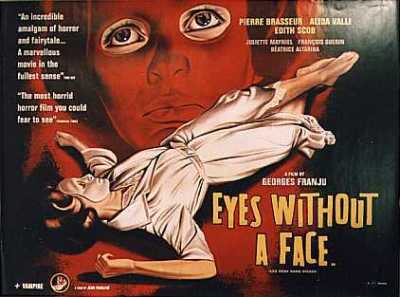
* Sculpting music with the ondes martenot - Radio France Internationale (English)
* Présentation détaillée des Ondes Martenot (French)
* Ondes Martenot : facts, videos, pictures, discography, works... (English)
* The presentation of Ondes Martenot C° Union des Enseignements Martenot (English)
* Audities Foundation Model 6 Ondes Martenot
* BBC Radio 6 Music - The Great Bleep Forward
* The Ondes-Martenot at Obsolete.com - includes two audio excerpts from the Turangalila-Symphonie (Quicktime format).
Retrieved from "http://en.wikipedia.org/wiki/Ondes_Martenot"

http://chaosradio.ccc.de/cre149.html
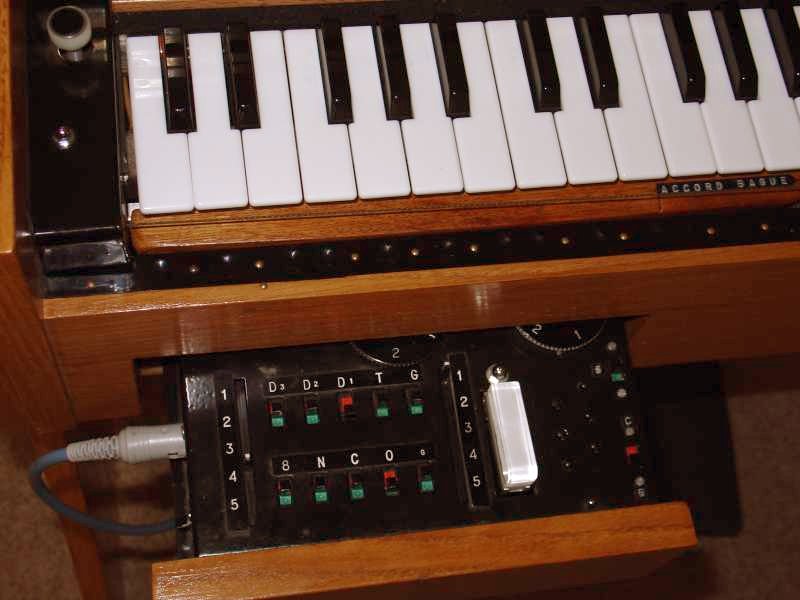
On http://www.alexbach.dk/abca/gallery.html there is a SOUND EXAMPLE:
abca playing the pre-historic synth, Ondes Martenot
The keyboard itself is four octaves wide, and in front of this you'll find the wire controller with the small ring through which you insert your index finger. The wire (which is actually a fine nylon cord) is stretched above a fingerboard in which you'll find small circular depressions that represent the white notes on the keyboard; and protruding metal studs that mark the positions of the black notes.
synthesized violins and cellos have never sounded this good! Then there were the flutes, whistles, atmospheric voices and amazing effects...
four permutations afforded by the two switches
- 'Button + Slider'
- 'Keyboard + Keyboard'
- 'Keyboard + Slider' mode allows you to control the pitch of the sound using the wire controller, but trigger envelopes using the keyboard.
- 'Button + Keyboard' mode, which allows you to play the pitch of the sound conventionally using the keyboard, articulating notes using the button.
completely intuitive and incredibly musical. The depressions and studs on the fingerboard made it simple to locate conventional semitones, and the ring moved without any discontinuities or unevenness. I could articulate each note individually and smoothly using the amplitude button, or create slides and vibrato without difficulty.
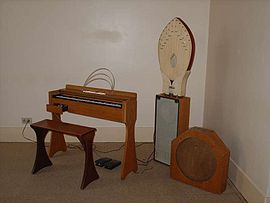
The ondes Martenot (which is French for "Martenot waves", also known as the ondium Martenot, Martenot and ondes musicales) is one of the first electronic musical instruments ever created. It was invented in 1928 by Maurice Martenot and it's sound was very similar to a Theremin – except with much more control over the timbre of the sound.
I'd stop short of calling it a real synthesizer, but it did have switches to control the sound. It even came with 4 very different speakers that could be switched on and off. The eerie sounds of the ondes Martenot were produced by thermionic valves (or vacum tube).
The Martenot was produced for 60 years all the way up until 1988, but a knockoff called the Ondéa started being produced in 2001.
 The really cool thing about this instrument is how it's played. On first sight, it looks like it operates like a piano, however it can be played either via the keyboard itself or by sliding a metal ring worn on the right-hand index finger in front of the keyboard. This allows the musician to play sweeping, wavering sounds very similar to the theremin. The keys on the keyboard actually have a little bit of lateral motion and you can modulate the pitch of a note up or down by pushing it left or right. (Maybe all those posers who vibrate their finger on the key when they play a synth with modulated sound dream of these)
The really cool thing about this instrument is how it's played. On first sight, it looks like it operates like a piano, however it can be played either via the keyboard itself or by sliding a metal ring worn on the right-hand index finger in front of the keyboard. This allows the musician to play sweeping, wavering sounds very similar to the theremin. The keys on the keyboard actually have a little bit of lateral motion and you can modulate the pitch of a note up or down by pushing it left or right. (Maybe all those posers who vibrate their finger on the key when they play a synth with modulated sound dream of these)
Now, it doesn't matter if you press a key or more the ring, those don't actually produce any sound (!). To produce a sound, first you must pull out a small drawer on the left hand side that contains various many controls. One oblong-shaped key controls the volume of the note by how far it is pressed – the deeper the push, the louder the note. Additionally, how it is pressed determines the attack of the note: quick taps produce short, staccato notes and more controlled and deliberate presses play legato.
Also in this drawer are flip-style switches that control the Martenot's sound. Each switch has its own sound color which can be stacked up to create a compound sound, just like an organ. The switches feature a sine wave, triangle wave, a pulse wave noise, and many other sounds.
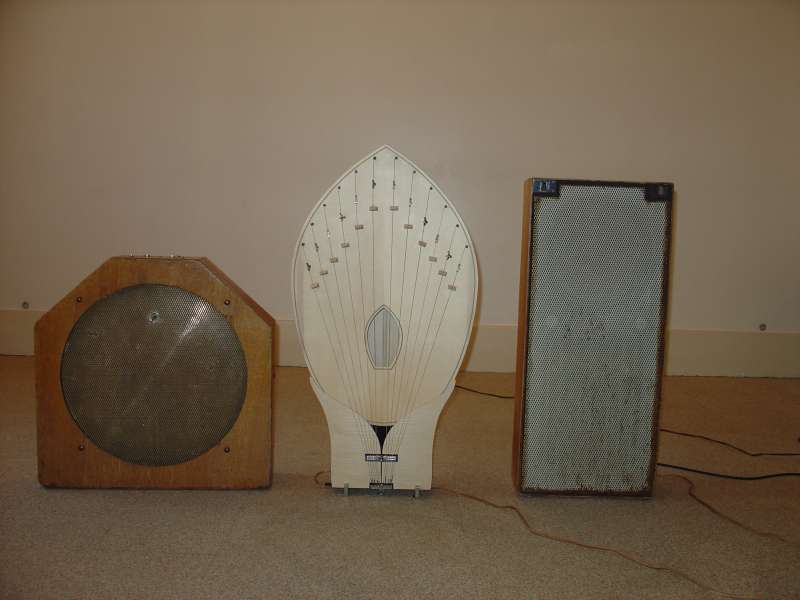 If that isn't enough, the are 4 different speaker systems (called "diffusers") that can be used to modify the sound. There is a standard speaker, a speaker with springs that add a type of reverb to the sound, a speaker with a "gong" as a diaphragm which produces very interesting harmonics and a speaker that is similar to a stringed instrument called a Lyre – great for drones and rich textures. Of course, you can use more than one speaker at a time and switch between them on the fly (take that, Leslie speakers!)
If that isn't enough, the are 4 different speaker systems (called "diffusers") that can be used to modify the sound. There is a standard speaker, a speaker with springs that add a type of reverb to the sound, a speaker with a "gong" as a diaphragm which produces very interesting harmonics and a speaker that is similar to a stringed instrument called a Lyre – great for drones and rich textures. Of course, you can use more than one speaker at a time and switch between them on the fly (take that, Leslie speakers!)
Jean Laurendeau is an absolute master. Here is a video of him demonstrating the instrument.
http://www.youtube.com/watch?v=Yy9UBjrUjwo![[ondes Martenot]](http://artfuljesus.0catch.com/Repertoire/ondesmartenot.jpg)
http://www.youtube.com/watch?v=aDrypZfUM7c
Les Ondes Martenot, improvisation par Monique Pierrot
31. December 2008 — Improvisation aux ondes Martenot par Monique Pierrot
http://www.youtube.com/watch?v=cpdK-kSW4KA
Sextuor d'ondes Martenot - pièce d'Olivier Messiaen
25. January 2009 — L'ensemble d'ondes Martenot de Jeanne Loriod, en 1983, jouait "Les Fusées" (partie 3) de la suite "La Fête des Belles Eaux" de son beau-frère Olivier Messiaen. Maurice Martenot avait inventé en 1922 l'un des plus anciens instruments électroniques : les ondes Martenot. (rediffusion)http://www.youtube.com/watch?v=Yy9UBjrUjwo
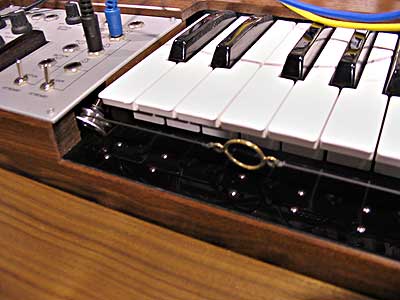
Ondes Martenot et Theremin music instrumentist
25. March 2007 — he played with RADIOHEAD ! and with orchestras, television, with 2 fabulous music instruments that you can hear and see here.
http://www.youtube.com/watch?v=IA00Wug6uyc
EARLY MONOPHONIC SYNTHESIZER
MUSIC COMPOSED FOR THE Ondes Martenot
Composer: Pierre Boulez
Work: Le visage nuptial (first version, 1946/47) (2 ondes Martenot)
Voices: soprano, contralto
Other instruments: piano, percussion
Composer: S. Bussotti
Work: Due voci
Voice: soprano
Other instruments: orchestra
Composer: Jacques Chailley
Work: Casa Dei (oratorio)
Voice: unspecified
Other instruments: choir, orchestra
Composer: Jacques Charpentier
Work: Stele
Voice: soprano
Other instruments: organ
Composer: Lindsay Cooper
Work: Nightmare
Voice: 2 unspecified voices
Other instruments: piano, marimba, percussion, drums, bassoon, synthesizer
Composer: Olivier Messiaen
Work: Saint François d'Assise (opera)
Voices: soprano, 3 tenors, 3 baritones, bass-baritone, bass, chorus
Other instruments: orchestra
Composer: Serge Provost
Work: Ein Horn (4 ondes Martenot)
Voices: soprano
Other instruments: none
Composer: Michel Redolfi
Work: Mare Teno
Voices: soprano
Other instruments: electronics
Composer: Giacinto Scelsi
Work: Uaxuctum (The Legend of the Maya City which destroyed itself for religious reasons)
Voices: 4 unspecified voices, mixed choir
Other instruments: orchestra
Uaxuctum (1969)
This extraordinary piece is in five movements, totaling approximately twenty minutes. In addition to the large chorus, written at an astonishingly difficult technical level, the work is scored for: four vocal soloists (two sopranos, two tenors, electronically amplified), ondes Martenot solo, vibraphone, sistrum, Eb clarinet, Bb clarinet, bass clarinet, four horns, two trumpets, three trombones, bass tuba, double bass tuba, six double basses, timpani and seven other percussionists (playing on such instruments as the rubbed two-hundred liter can, a large aluminum hemisphere, and a two-meter high sheet of metal). The chorus is written in ten and twelve parts, incorporating all variety of microtonal manipulations, as well as breathing and other guttural and nasal sounds. This piece is certainly Scelsi's most difficult to perform, and was not premiered until October 12th, 1987 by the Cologne Radio Chorus and Symphony Orchestra. Uaxuctum is subtitled: "The legend of the Maya city, destroyed by themselves for religious reasons" and corresponds to an actual Maya city in Peten, Guatemala which flourished during the first millennium AD; in addition, the Mexican state of Oaxaca comes from the same ancient meso-American root.
This is an intensely dramatic work, and the most bizarre in Scelsi's output. It depicts the end of an ancient civilization - residing in Central America, but with mythical roots extending back to Egypt and beyond - it is the last flowering of a mystical and mythological culture which was slowly destroyed by our modern world. In this case, Scelsi says, the Mayans made a conscious decision to end the city themselves. Uaxuctum incorporates harmonic elements throughout, and is extremely difficult to come to terms with.
The first movement, the longest of the five, is a grand overture; it begins in quiet contemplation, only to be interrupted by the violent mystical revelation of the chorus propelling this story into the present from the distant past, and then sinking back into meditative tones with a presentiment of the upcoming adventure. In the wild and dramatic second movement, we enter the world of the Mayans, complete with mysticism in all aspects of life; it is an incredible and violent tour-de-force of orchestral writing. The short third movement opens with an atmosphere of foreboding, building into a realization of things to come, and reaching a decision. After a few seconds of silence, the city of Uaxuctum is quickly destroyed and abandoned. The fourth movement is dominated by the chorus throughout, and presents the wisdom gained by the Mayans as they gradually fade into oblivion. The fifth movement returns to the opening mood, and gives a dim recollection of the preceding events which have now been told, in abstract form, to our time and civilization.
There really are no proper words to describe this amazing piece, which presents Scelsi at his most daring and innovative. It is a world all to itself, and a warning.
Composer: Gilles Tremblay
Work: Kékoba
Voices: soprano, mezzo-soprano, tenor
Other instruments: percussion
Composer: Edgard Varèse
Work: Ecuatorial (2 ondes Martenot or theremin cellos)
Voices: baritone
Other instruments: orchestra of 4 trumpets, bass trombone, 3 tenor trombones, organ, piano, 6 percussion
Composer: Patrik Vidjeskog
Work: Tre brev till det ogripbara
Voices: baritone, mixed choir
Other instruments: percussion, organ, string orchestra
http://artfuljesus.0catch.com/Repertoire/haunting.html

Thomas Bloch musician and the rare instruments he plays ondes Martenot glassharmonica cristal Baschet he has made 2500 concerts and 100 CD with Radiohead Gorillaz Tom Waits Valery Gergiev ondes martenot glass harmonica cristal Baschet Lasry ondes martenot glass harmonica cristal Baschet konzertagentur ondes martenot glass harmonica cristal Baschet ondes martenot best soloist virtuose virtuoso solist soliste solisten ondes martenot glass harmonica cristal Baschet Lasry structures sonores ondes martenot glas harmonika concert agency agence de concert cristal baschet agencies concerts konzert agentur agent ondes martenot ondes martenot ondes martenot ondes martenot ondes martenot onde martinot onde martinot onde martinot onde martinot onde martinot glass harmonica
|  musician performer of rare instruments "Thomas Bloch is unquestionnably a virtuoso and a musician" "Thomas Bloch est, sans discussion, un virtuose et un musicien" The New York Times GLASS HARMONICA ONDES MARTENOT CRISTAL BASCHET 2 5 0 0 C O N C E R T S 1 0 0 RECORDINGS with R A D I O H E A D M I L O S F O R M A N Amadeus G O R I L L A Z Monkey: Journey to the West T O M W A I T S / B O B W I L S O N The Black Rider DAFT PUNK (T. Bangalter)/GASPAR NOE Enter the void E M I L I E S I M O N The March of Penguins M A R I A N N E F A I T H F U L L V A N E S S A P A R A D I S J O H N C A G E O L I V I E R M E S S I A E N J E A N - F R A N C O I S Z Y G E L P H I L I P P E S A R D E Z A Z I E A R T H U R H L A R A F A B I A N M I L A N O S C A L A M U S I C C E N T E R L O S A N G E L E S WARSAW PHILHARMONIC ORCHESTRA CENTENARY M Y U N G - W H U N C H U N G V A L E R Y G E R G I E V D O N I Z E T T I M O Z A R T NEW ! WATERPHONE - THEREMIN CELLO |
It is possible to hear excerpts of this CD and to see more videos on the audio - video page of this site.
- The ondes Martenot in brief...
| Maurice Martenot plays the 1rst model (1928) he used only a ribbon and had to stay a little way from the unit | Maurice Martenot (1898 - 1980) found the principle of ondes Martenot (sometimes written onde Martenot, Martenot waves in English, fale martenota in Polish, ondas martenot in Spanish or, by mistake : ondes Martinot), when, as a serviceman in radio transmissions during the first world war, he noticed «the purity of the vibrations produced by the lamps of a condenser whose intensity can be made to vary». It was one of the first electric instruments in the world and the only one of that time to have given rise to a vast repertoire and to be still played today. Maurice Martenot was also a cellist and the inventor, with his sister, of a method of artistical education. He was above all interested in the musical means offered by electricity and not so much by research in sound. He started doing research work for ondes Martenot in 1919. But he did not present the instrument to the public until May 1928 at Paris Opera. His immediate triumph was followed by a world tour. |
| Seven successive specimens made by Maurice Martenot were born, each one bringing innovations. The bases of the last instrument, transistorised, still played and taught in about ten Music Academies in France and in Canada, were fixed in 1975. The building of Ondes Martenot stopped in 1988. His son Jean Louis then started working on a digital instrument. In 1995, engineer Ambro Oliva makes the ondéa, a close instrument. REVIVAL !!! From 2008, Jean-Loup Dierstein works on rebuilding the original ondes Martenot. The production will begin before the end of 2009 - write here for informations about this new instrument. | 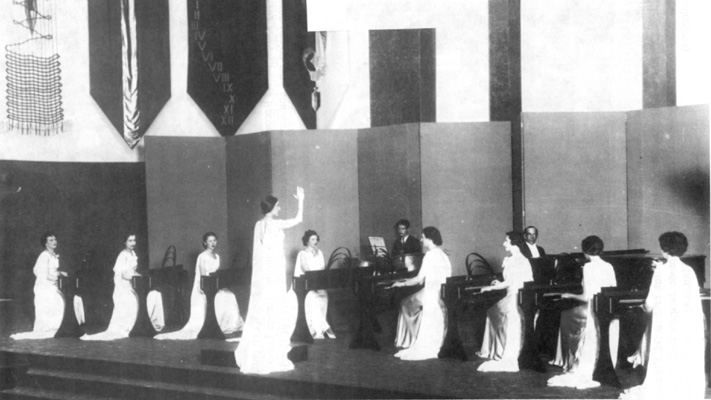 Ondes Martenot octet and two pianos conducted by Ginette Martenot (around 1935) |
There is about 1500 works composed for the ondes Martenot by Varèse, Messiaen, Honegger, Scelci, Boulez, Jolivet, Murail... It is also widely used in film music (Mad Max, Mars attacks, Fantomas, la Marche de l'Empereur - the March of Penguins...) and in popular music (Brel, Radiohead, Gorillaz, Vanessa Paradis...).
| | THE ONDES MARTENOT by Thomas Bloch © Thomas Bloch / Naxos, 2004 from the booklet of the Thomas Bloch's CD "Music for ondes Martenot" (réf.: Naxos 8.555779) english translation : Susannah Howe |
| The musician's left hand works the touche d'intensité (intensity key) located in a little drawer on the left side of the instrument. This controls the sound level, something like the volume control of a radio. Extremely sensitive, it has a two-centimetre range of movement and can take the volume from zero to earsplitting. It acts as an extension of the player's thought process, enabling a wide variety of nuance, phrasing and attack (accents, slurring, detached notes, staccato, percussive effects, and so on). In order to produce a sound the musician has to play the keyboard (or ribbon) and depress the button simultaneously. The action of the latter is similar to that of a bow, recalling once more Martenot's beloved cello. Also located in the drawer are seven switches that control the choice of wave form (sounds) and their mixing, enabling numerous timbre combinations. On the latest model (1975), they are designated by letters rather than by numbers as on previous models: O for Ondes (sinusoid waves), C for Creux (peaklimited triangular signal), g for petit gambé (a square signal whose intensity can be regulated using a selector), G for Gambé (square signal), N for Nasillard (pulse signal), 8 for Octaviant (reinforced first harmonic, whose intensity can be regulated using a selector) and T for Tutti (combination of all timbres). There are also two switches which can be used to obtain variable-intensity pink noise, comparable to a Puff (S for Souffle), and to filter the harmonics (F for Feutre), creating a mute effect. | Playing on the keyboard (right hand) while the left hand controls the intensity key |
| Over the decades since its invention, there have been seven models of the ondes Martenot, all incorporating various improvements. The 1919 instrument, a kind of theremin, was not seen as viable by Martenot and his first "official" model was that of 1928. This only had the ribbon, which the player pulled and released with the right hand to slide from one note to another. The performer stood a little way from the unit and controlled the volume using a control in a drawer on a table. The second model (1929) was more compact and included a dummy keyboard with a pointer to indicate the pitch of the notes played on the ribbon. The third model (1930) could be played from either a seated or standing position and the ribbon was positioned above a dummy wooden keyboard which worked as a visual reference. The next model had no ribbon but had a working, sprung keyboard. Ribbon and functioning keyboard finally appeared together in version five in 1937, the year in which Messiaen composed his Fête des Belles Eaux for six ondes Martenot (which was performed on a boat floating down the Seine as part of Exposition Universelle). Martenot began giving classes in the instrument at the Paris Conservatoire National Supérieur de Musique in 1947, and a dozen or so more courses were later established in France and Canada, encouraging official recognition of the instrument. Model six (1955) was smaller and lighter owing to progress made in the field of electronics. The seventh and final version (1975) replaced valves with transistors. Around 370 instruments were manufactured in Martenot's workshop in Neuilly-sur-Seine, near Paris, along with a number of non-professional models: simplified versions for school use, chamber music versions, one combined with a radio and turntable and one designed to play raga modes (built in 1932 for the Indian poet and musician Rabindranath Tagore), among others. Production ended in 1988 on the retirement of Marcel Manière, Martenot's assistant since 1951. Jean-Louis Martenot, one of Maurice's sons, worked on a digital version, but this was not pursued. In 1995, engineer Ambro Oliva makes the ondéa, a close instrument. REVIVAL !!! After 2008, Jean-Loup Dierstein, a wordly french renowned specialist of vintage keyboards, works on rebuilding the original ondes Martenot with the support of Maurice Martenot's son. The production will begin before the end of 2009. The instrument is exactly the same than the very last ondes Martenot model made in 1988 - write here for informations about this new instrument. | Playing with the ribbon 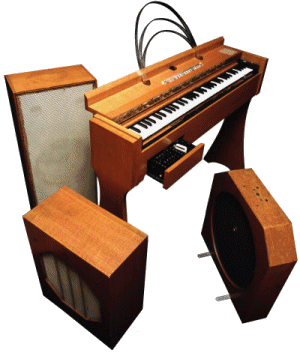 The keyboard and from left to right the "diffuseurs" "principal" (D1), "résonance" (D2), "métallique" (D3) |
SYNTHESIZERS AND SAMPLERS
| A typical synthesizer contains three most basic modules: The third section usually contains the VCA module, which allows you to set different characteristics of sound int terms of it's decay or attack as well as the VCF Envelope filter, which may change the characteristics of filter actions depending on the time.
Maurice Martenot (1898 - 1980) invented it when he worked as a radio technician during World War I, He noted "the purity of the vibrations produced by the tubes, which can be controlled with a capacitor". This was one of the first electronic instruments in the world, and the only, which inspired a huge repertoire of songs, and that is still in use today. Martenot began work on the Ondes Martenot in 1919. It does not, however, was presented to the public until May 1928, when it suffered unprecedented success at the Paris Opera. This triumph allowed Martenot the world concert tour. Trautonium is an instrument discovered by German engineer Dr. Freidrich'a Adolf Trautwein, who first presented it at an exhibition in 1930r. In the years 1932-35 the serial production was started by the Telefunken company. The famous music writers using that instrument were Paul Hindemith (Concertina for Trautonium and Orchestra), Höffer, Genzmer, Julius Weismann, and also Oscar Hall, who became a virtuoso of this instrument, and even continued to work on its development, by introducing its own variations - 'Mixtur-Trautonium', 'Concert-Trautonium' and 'Radio - Trautonium'. Dr. Freidrich Trautwein also invented the 'amplified harpsichord' (1936) and 'Electronic Bells' (1947). Trautonium 2 - mp3>>
Once the ownership of the machine was transferred to Columbia-Princeton Electronic Music Center in 1959, Milton Babbitt used it to create such works as' Philomèle ' for soprano and synthesized sound. A sound sample from Milton Babbit's "Ensebles For Synthesizer": RCA Mark II .mp3>> Clearly, the Mellotron was a very complicated and expensive instrument, which gaves the possibility, however of extremely expressive sounds not possible to obtain in any other way. An example of one of the best uses of Mellotron in the history of music is "In The Court Of The Crimson King" album by the group King Crimson. The following photos show internal mechanics of the Mellotron and several other of its versions:
|
| The history of synthesizer and sampler development - part II Here is a sample of the Mellotron sound from that famous recording mp3 >>> Another very important inventor in the history of music was Robert Moog. He invented a modular synthesizer, which consists of several modules combined with each other in different ways by using cables. Although he was not the first of the inventors of a modular synthesizer, earlier than him was Büchl Don, who also introduced the initial concept of this sequencer, but Moog was important in the sense of establishing a certain standard in the construction of electronic synthesizers, which since then are reproduced by countless companies: the Music Control Voltage (VCA). Modular Moog synthesizers included voltage control setting of 1 Volt per octave, to control the basic functions: pitch (VCO), cut-off filter (VCF) and volume (VCA). Envelope, low frequency oscillators and keyboard could give the small voltage needed. Although the Don Buchla synthesizer also used voltage controls as well as Moog, but did not have such precise adjustment, it's settings were rather experimental and not suitable to the broader use in music just like Moog's synthesizer.
Examples of Moog Modular synthesizer sounds: Bass .mp3>>> Vibrations .mp3>>>
The following photo shows that first mass-used sampler:
Here is the Emulator II:
For comparison, let's listen to sounds of Korg M1 .mp3>>> Therefore, the Roland D-50 is on the short list of most beloved synthesizers of all time. It is still a favorite among professional keyboard players. It is much easier to use than the Yamaha DX-7. It combines the technology of 8-bit PCM samples with the sounds generated in the typical synthesizer way, the so-called LAS technology (Linear Arithmetic Synth), so it is able to provide a very unique and complex sounds. This popular synthesizer is in wide use in all music styles among artists such as Eric Clapton, Enya, 808 State, Jea n Michael Jarre, Vince Clarke, Apollo 440, Eat Static, LTJ Bukem, Fluke, Information Society, Lab-4, Gary Numan, Rick Wakeman, Kitaro, Rush, Boston and Nick Rhodes of Duran Duran.
The last synthesizer presented here did not become so popular as the previous ones, but its importance lies in the fact that it introduced a new technology to create new sounds: the modeling. This is the Yamaha VL1. Its drawback was the high cost. Yamaha VL1 was first available in the market synthesizer using sound modeling techniques. It was very expensive and could only do a few things (for example, play as a true saxophone). But it had the ability to do those things really well! Which is why it inspired a new wave of modeling synthesizers (such as the Clavia Nord Lead and the Korg Prophecy, which was able to deliver a lot of strange sound effects, being an affordable solo synthesizer. Therefore, it enjoyed a big commercial success. Like the Synclavier and Fairlight, the Yamaha VL1 can be seen as the beginning of a new generation of advanced synthesizers.
The rhythm machine modules-rhythmic synthesizers and percussion samplers
|

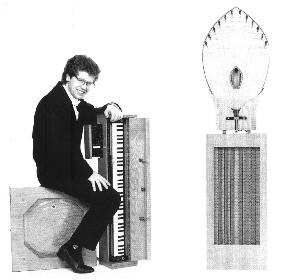
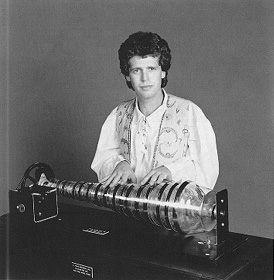
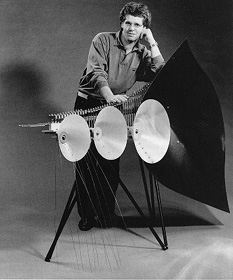
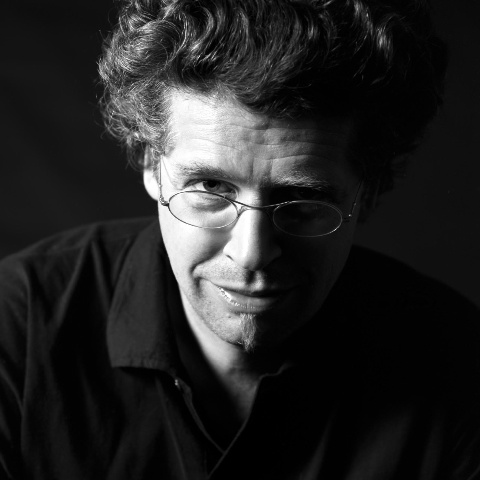
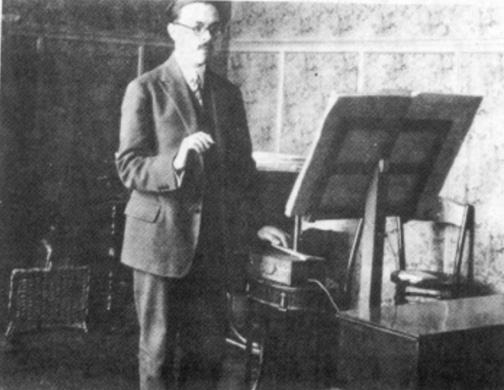
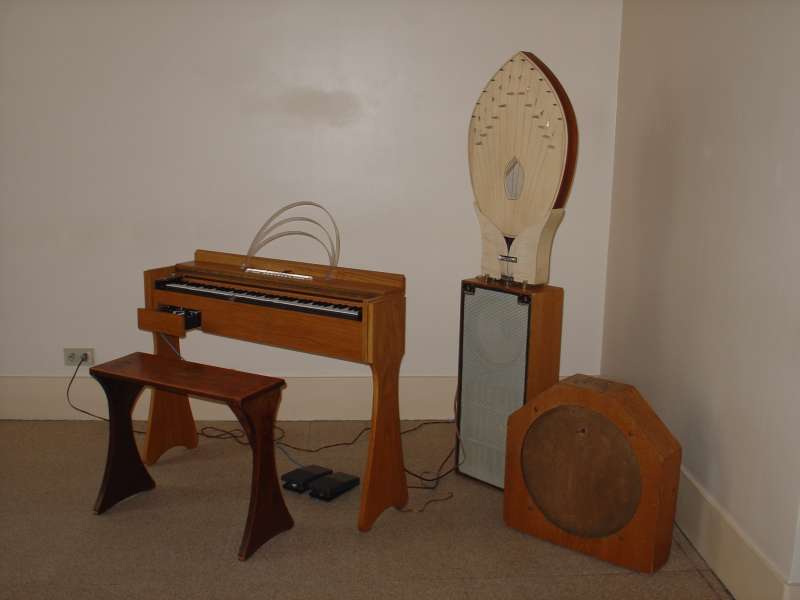
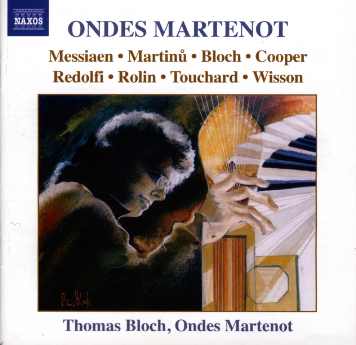
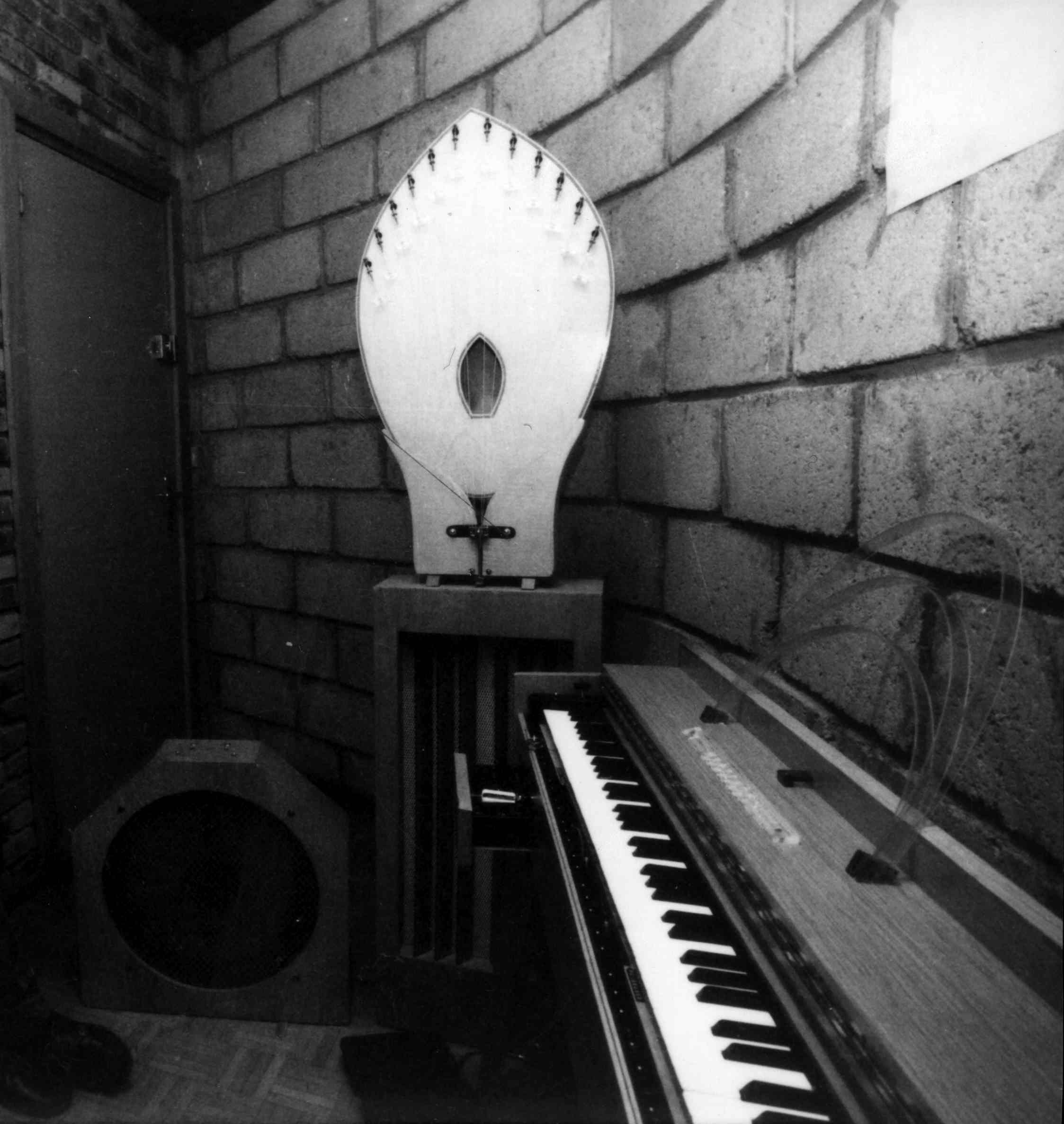
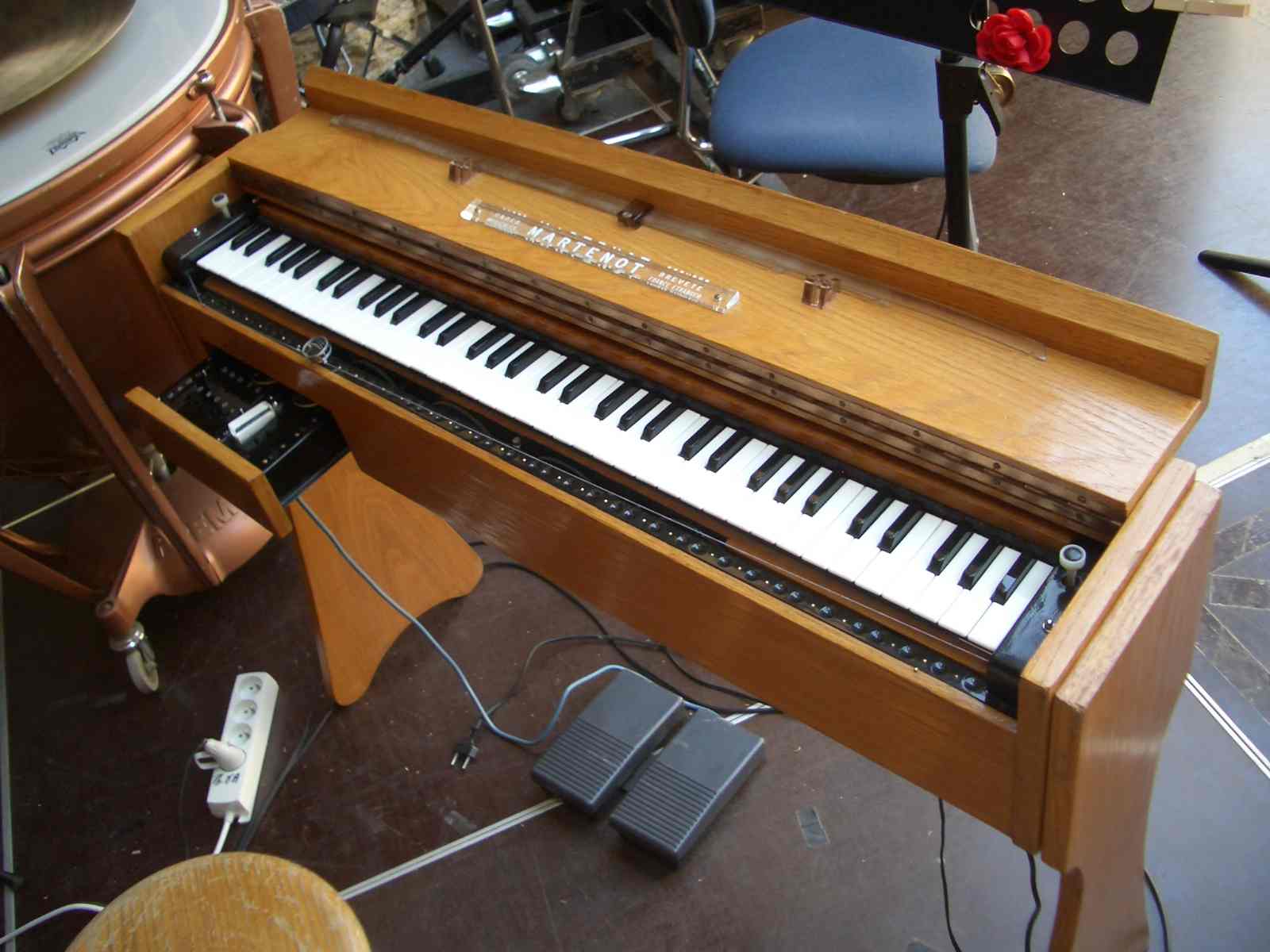
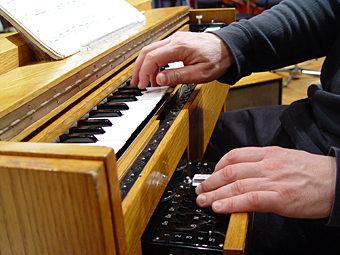
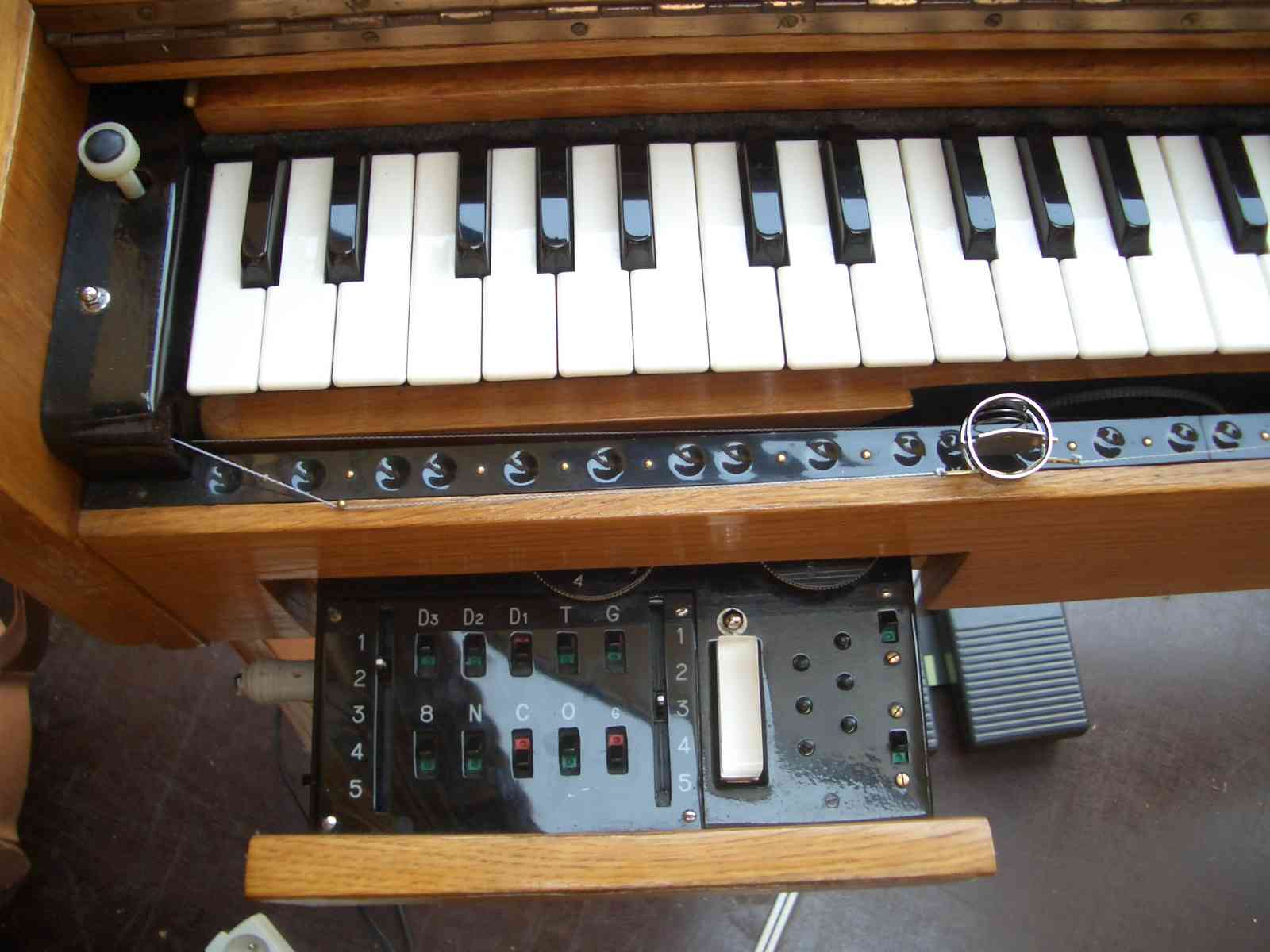
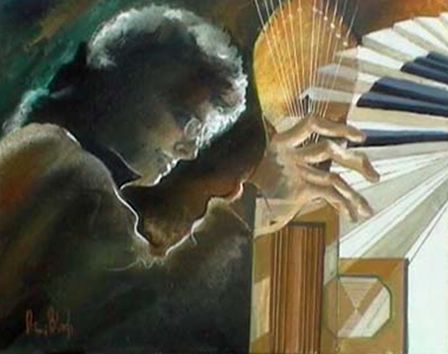
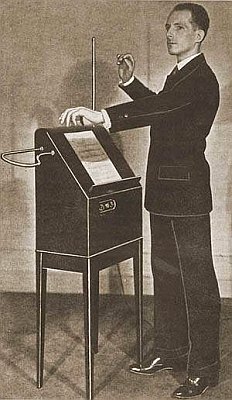
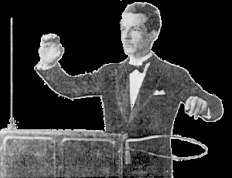
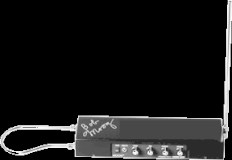
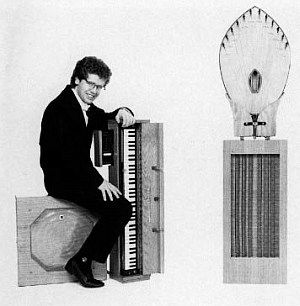
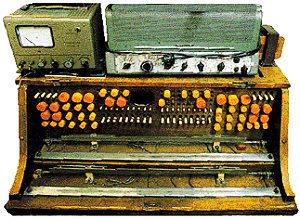
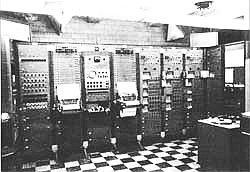

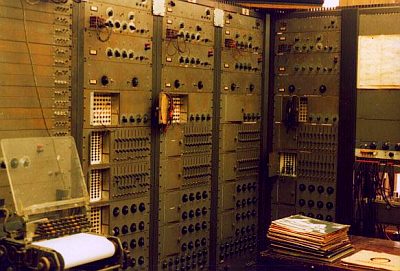
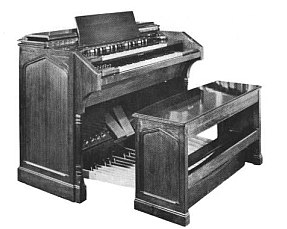
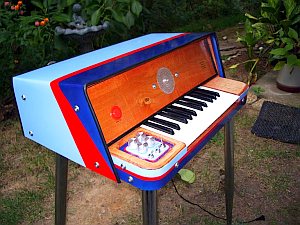
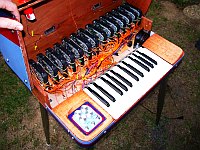
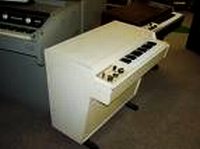
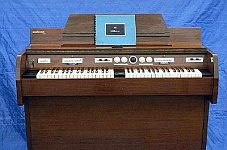
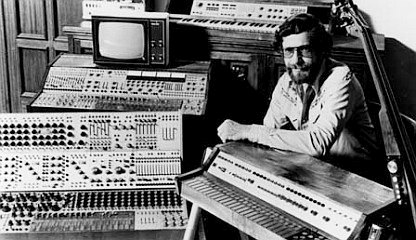
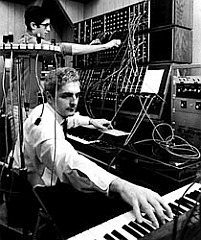
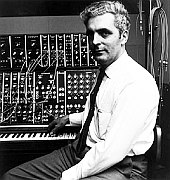
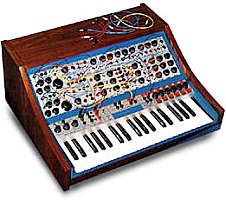
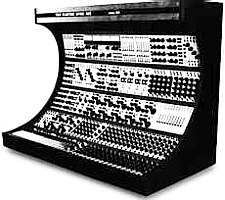

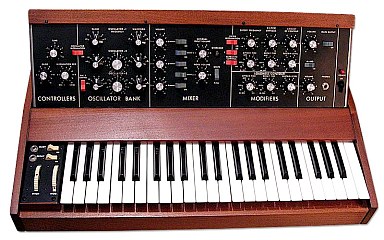
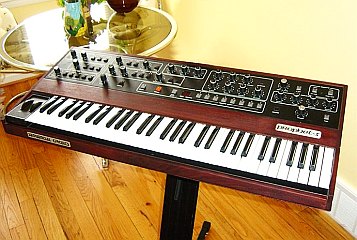
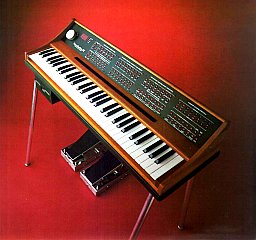
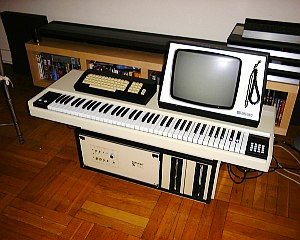
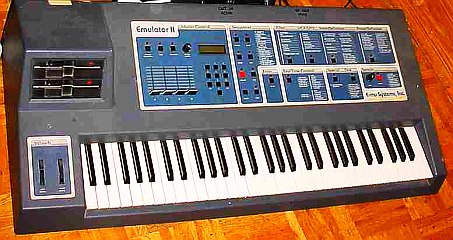
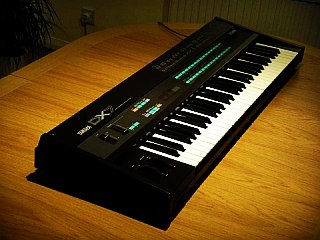

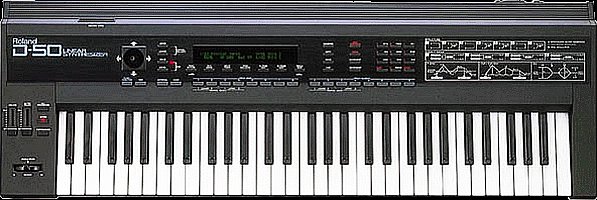
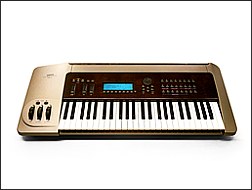
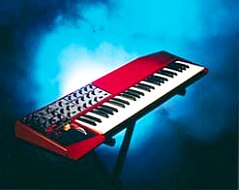
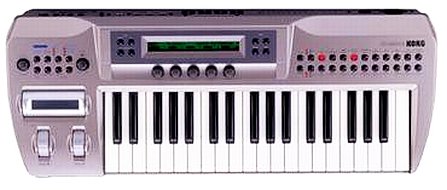
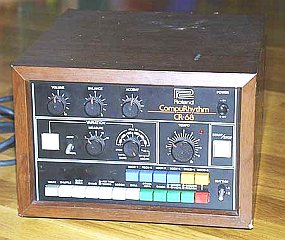
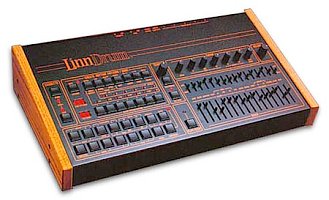
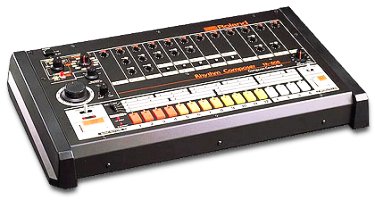

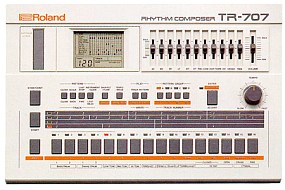
 Earth's magnetic field:
Earth's magnetic field:

0 Comments:
Post a Comment
<< Home